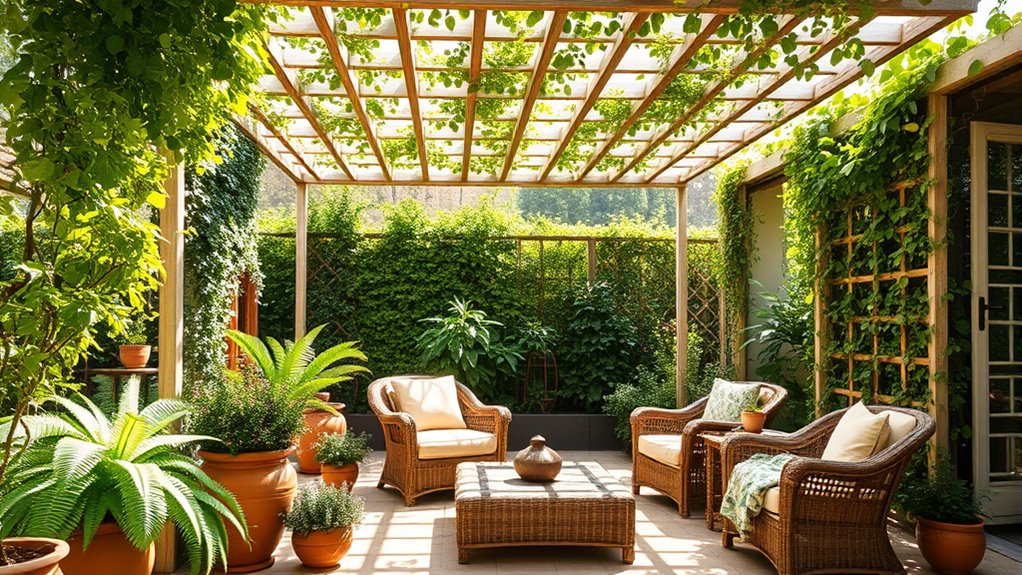Biophilic design helps you bring nature into your patio by blending greenery, natural materials like wood and stone, and organic shapes. You can select plants that add color and texture, create focal points with vertical gardens, and use durable natural decor to enhance the space’s beauty and calmness. This approach boosts your outdoor ambiance, supporting wellness and relaxation. Discover how to transform your patio into a vibrant sanctuary that nurtures both mind and body as you explore further.
Key Takeaways
- Integrate natural elements like plants and water features to create a calming, nature-inspired outdoor space.
- Use indoor greenery, such as potted plants and vertical gardens, to enhance visual interest and air quality.
- Incorporate natural materials like wood, stone, and bamboo in furniture and decor for a warm, organic aesthetic.
- Combine greenery with natural fabrics and textures to foster tranquility and visual cohesion.
- Design for durability and low maintenance to sustain a harmonious, inviting patio environment over time.

Biophilic design is a creative approach that integrates natural elements into built environments to improve well-being and productivity. When it comes to patios, this concept transforms your outdoor space into a sanctuary that feels both inviting and revitalizing. One of the most effective ways to achieve this is by incorporating indoor greenery, which brings the vibrancy of nature directly into your patio area. You can select a variety of plants, from lush ferns and cascading vines to flowering shrubs, to add texture and color. These plants not only create a calming atmosphere but also improve air quality, making your outdoor space healthier and more invigorating. To enhance this natural connection, consider using natural materials like wood, stone, and bamboo in your furniture and decor. These materials naturally complement greenery and help establish a seamless progression between indoor and outdoor environments.
Using indoor greenery strategically allows you to craft focal points that draw attention and create visual interest. For example, a vertical garden or a collection of potted plants placed along a walkway can serve as a living art installation that energizes your patio. When selecting greenery, think about the level of maintenance you’re comfortable with, as some plants thrive with minimal care, while others require more frequent attention. Incorporating natural materials not only supports the plants but also adds texture and warmth to your patio. Wooden benches, stone pathways, and bamboo fencing create a natural aesthetic that harmonizes with the greenery, fostering a sense of tranquility and cohesion. Additionally, choosing low-maintenance plants can make caring for your patio more manageable and enjoyable.
In addition, natural materials tend to age gracefully, developing unique patinas that add character over time. This durability makes them ideal choices for outdoor settings that are exposed to the elements. Combining indoor greenery with these materials results in a balanced, organic feel that invites relaxation and socialization. You can enhance this effect by adding natural fabric cushions, woven rugs, or clay pots, further emphasizing the connection to nature. When you design your patio with biophilic principles, you’re not just creating a beautiful space; you’re fostering a sanctuary that nurtures your mind and body. By thoughtfully choosing indoor greenery and natural materials, you build a harmonious environment that promotes well-being and makes your outdoor living experience more enjoyable and sustainable.
Frequently Asked Questions
How Does Biophilic Design Impact Mental Health?
You might wonder how your environment affects your mental health. Incorporating natural elements, like plants and natural light, offers mental health benefits by reducing stress and promoting relaxation. When you bring nature into your space, it helps you feel calmer and more centered. This connection to nature through biophilic design encourages stress reduction and boosts your overall well-being, making your outdoor space a restorative retreat.
What Are Cost-Effective Ways to Incorporate Nature?
To incorporate nature cost-effectively, you can add garden art like sculptures or hanging planters to your patio. Use weatherproofing options to protect your plants and decor, ensuring longevity. Consider DIY projects such as building small green walls or container gardens, which are affordable and easy to maintain. These choices bring natural beauty to your space without breaking the bank, creating a calming, inviting outdoor area.
Which Plants Are Best for Shaded Patios?
So, you want shade-loving plants that thrive in your dim patio dungeon? Lucky for you, low light greenery exists, like ferns, hostas, and impatiens—perfect for those shady corners. These plants don’t demand sunlight and add lushness without much fuss. Just remember, your shaded patio isn’t a plant desert; it’s a cozy hideaway for these low-light champions. Go ahead, turn that gloomy nook into a green paradise!
How Does Biophilic Design Affect Property Value?
You might wonder how biophilic design impacts property value. Incorporating natural elements like greenery and natural materials boosts property appreciation and enhances market appeal. When you bring nature into your home, it creates a relaxing, inviting atmosphere that attracts buyers. This design approach not only elevates aesthetics but also demonstrates your commitment to sustainable living, making your property more desirable and potentially increasing its market value over time.
Are There Any Maintenance Challenges With Natural Elements?
Did you know that 60% of homeowners find maintaining natural elements challenging? When adding plants and other natural features, you’ll need to stay on top of plant care and pest control to keep your patio looking great. Natural elements can attract pests and require regular watering, pruning, and monitoring. While they add beauty and value, these maintenance challenges require commitment, so plan accordingly to enjoy a lush, inviting space.
Conclusion
By incorporating biophilic design into your patio, you bring nature’s serenity into your everyday life. It’s a simple act that transforms a concrete space into a lush retreat. Yet, in doing so, you also reconnect with the wild, reminding yourself that amidst modern chaos, the natural world remains a essential sanctuary. Embrace this balance—where man-made comfort meets nature’s untouched beauty—and let your patio become a haven that nurtures both mind and spirit.









